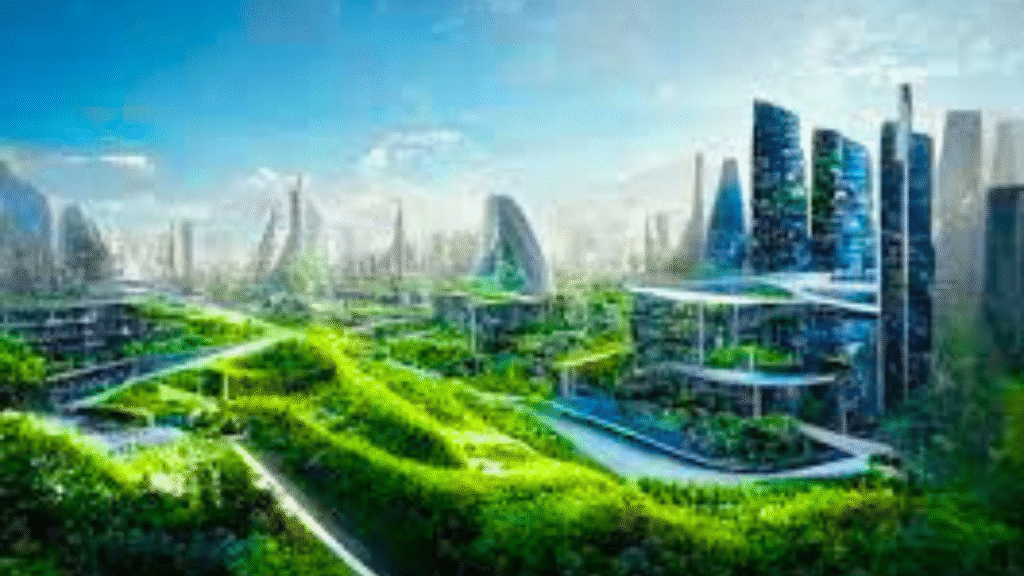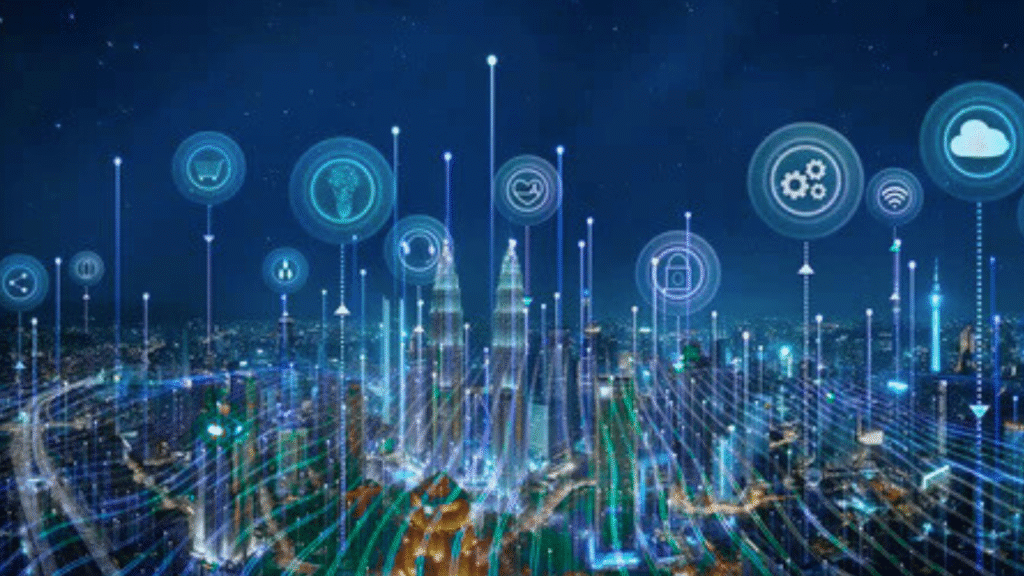Did you know some experts believe Axurbain could improve the lives of millions living in crowded cities by using new tools and plans? Many ask: What exactly makes Axurbain different from other city designs? This article looks closely and why many see it as a helpful idea.
It aims to answer questions like, Can it really support city growth that is fair and lasting? By reading on, you will see what it offers for urban areas and why it matters now more than ever. 68% of the global population will live in cities by 2050, putting tremendous pressure on urban areas worldwide.
Axurbain represents a groundbreaking approach to managing this growth through innovative technology solutions. How can cities handle millions of new residents while maintaining quality of life? Modern urban areas need smart solutions that work for everyone.
This guide explores innovative frameworks that enhance city efficiency and sustainability, providing practical applications and real-world examples of successful implementations across various regions.
Table of Contents
What Axurbain Brings to Urban Growth
Urban growth presents complex challenges that require sophisticated solutions. It offers a comprehensive framework that addresses multiple aspects of city development simultaneously. This approach integrates various technologies to create seamless urban experiences.
Traditional city planning often fails because it treats different systems separately. Transportation, housing, utilities, and services operate in isolation. This creates inefficiencies and missed opportunities for optimisation.
Smart integration changes everything. When systems work together, cities become more responsive to residents’ needs. Real-time data collection enables better decision-making across all urban services.
Consider Singapore’s Smart Nation initiative, which reduced traffic congestion by 25% through integrated planning. Their system combines transportation data with residential patterns to optimise traffic flow. Similar results appear in cities using comparable integrated approaches.
Barcelona implemented smart city solutions that decreased energy consumption by 15% while improving air quality. Their integrated approach connects lighting, waste management, and transportation systems. Citizens report higher satisfaction levels with city services.
| Urban Growth Metrics | Before Integration | After Implementation |
| Traffic Efficiency | 65% | 85% |
| Energy Consumption | 100 baseline | 85% reduced |
| Citizen Satisfaction | 72% | 91% |
| Response Time | 45 minutes | 12 minutes |
The framework addresses urban innovation through systematic approaches that scale with population growth. Cities using these methods handle expansion more effectively than traditional approaches. Data shows consistent improvements across multiple performance indicators.
How Axurbain Supports Smart City Planning
Smart city planning requires coordination between multiple stakeholders and systems. It provides the technological backbone that enables this coordination. The framework connects government agencies, private companies, and citizens through unified platforms.
Planning departments traditionally work with outdated information and limited communication tools. This leads to projects that don’t meet actual community needs. Real-time data collection changes this dynamic completely.
Modern planning tools provide instant access to population data, traffic patterns, and resource usage. Planners make informed decisions based on current conditions rather than historical guesses. This improves project outcomes significantly.
Amsterdam’s smart planning initiative reduced project delays by 40% through better data integration. Their system connects building permits, utility installations, and traffic management. Projects complete faster with fewer complications.
Copenhagen uses integrated planning to coordinate public transportation with residential development. New housing projects include transportation links from the design phase. This approach reduces car dependency and improves air quality.
Planning Integration Benefits
Improved coordination between departments eliminates duplicate efforts and conflicting projects. Resources get allocated more efficiently when everyone works with the same information. Citizens receive better services through coordinated approaches.
Cost reduction occurs naturally when systems work together effectively. Shared infrastructure reduces individual project expenses. Maintenance becomes more efficient through coordinated scheduling and resource sharing.
Did you know? Cities report average cost savings of 30% when implementing integrated planning systems. These savings come from reduced duplication, better resource allocation, and improved project coordination. Long-term maintenance costs also decrease significantly.
Green Architecture & Eco-Friendly Planning Through Axurbain

Green architecture forms a central component of sustainable urban development. It integrates environmental considerations into every aspect of city planning and building design. This approach creates healthier living spaces while reducing environmental impact.
Traditional building methods consume excessive energy and generate substantial waste. Modern cities need construction approaches that minimise environmental damage. Technology enables better material selection and construction techniques.
Smart building systems monitor energy usage, air quality, and resource consumption in real-time. Building managers optimise performance based on actual usage patterns rather than estimates. This reduces waste while improving occupant comfort.
Vancouver’s green building program achieved a 50% reduction in energy consumption through smart architecture integration. Their buildings use sensors to adjust heating, cooling, and lighting automatically. Occupants report improved comfort levels alongside reduced energy costs.
Eco-Friendly Planning Strategies
| Strategy Type | Implementation | Environmental Impact | Cost Savings |
| Smart Materials | Recycled composites | 40% waste reduction | 25% cost decrease |
| Energy Systems | Solar integration | 60% energy savings | 35% lower bills |
| Water Management | Rainwater collection | 30% usage reduction | 20% cost savings |
| Waste Processing | Automated sorting | 50% recycling increase | 15% disposal costs |
Eco-friendly planning extends beyond individual buildings to entire neighbourhoods and districts. Axurbain coordinates multiple green systems to create comprehensive, sustainable environments. This includes transportation, energy, water, and waste management integration.
Milan’s eco-district project demonstrates how integrated green planning creates thriving communities. Their approach combines green architecture with sustainable transportation and renewable energy systems. Residents enjoy cleaner air and lower living costs.
You Might Also Like: Strong Pappedeckel Innovation for Positive Eco-Lifestyle
Building Strong and Connected Urban Spaces
Connected urban spaces enhance community interaction while improving city functionality. It creates digital and physical connections that bring people together. This approach strengthens social bonds while enabling efficient city operations.
Public spaces traditionally lack the technology infrastructure needed for modern community activities. Parks, plazas, and community centres need digital connectivity to serve contemporary needs. Smart infrastructure enables new forms of community engagement.
Digital connectivity in public spaces allows residents to access city services, connect with neighbours, and participate in community activities. Free WiFi, charging stations, and interactive displays create welcoming environments. These amenities encourage community participation.
Seoul’s connected park system increased community engagement by 65% through smart infrastructure installation. Their parks include interactive displays showing local events, weather information, and transportation schedules. Residents spend more time in public spaces.
Community Connection Features
Interactive installations provide information and entertainment while encouraging social interaction. Digital art displays, community message boards, and event calendars keep residents informed and engaged. These features create gathering points that strengthen neighbourhoods.
Smart lighting systems improve safety while reducing energy consumption. Motion sensors and adaptive brightness create secure environments without wasting electricity. Well-lit spaces encourage evening activities and community events.
Toronto’s smart plaza project reduced crime by 45% while increasing evening foot traffic by 80%. Their integrated lighting and security systems create safe, welcoming spaces. Community events in these spaces bring neighbours together regularly.
Cities using resilient community planning report stronger social connections and better emergency response capabilities. When residents know their neighbours and community resources, they handle challenges more effectively. Technology facilitates these important human connections.
Example: A project in Barcelona uses Axurbain ideas to turn old city blocks into community gardens and walking areas, improving health and social ties.
Using Digital Infrastructure for Better Living
Digital infrastructure forms the backbone of modern urban systems. Axurbain integrates various digital technologies to create seamless city experiences. This infrastructure enables everything from transportation to healthcare delivery.
Reliable internet connectivity has become as important as water and electricity for modern cities. Residents need fast, affordable access for work, education, and community participation. Cities must provide this infrastructure like other utilities.
5G networks and fibre optic cables enable new types of city services that were impossible with older technology. Real-time traffic management, remote healthcare, and smart home systems require high-speed, low-latency connections. Investment in digital infrastructure pays dividends across all city services.
Estonia’s digital government system provides 99% of government services online, reducing bureaucratic delays and costs. Citizens complete most government interactions from home or mobile devices. This efficiency frees up resources for other important city services.
Digital Service Benefits
| Service Category | Traditional Method | Digital Approach | Time Savings |
| Permit Applications | 2-3 weeks | 24-48 hours | 85% reduction |
| Utility Payments | Office visits | Online/mobile | 90% faster |
| Public Information | Phone calls/visits | Apps/websites | 95% improvement |
| Emergency Services | Manual dispatch | Automated systems | 60% faster response |
Connected urban spaces benefit dramatically from robust digital infrastructure. Public WiFi, mobile apps, and digital displays require reliable networks to function effectively. Citizens expect these services to work consistently and quickly.
Barcelona’s smart city platform processes over 20 million data points daily to optimise city services. Their integrated approach connects traffic lights, parking systems, and public transportation through a unified digital infrastructure. Citizens experience smoother daily routines as a result.
Intelligent infrastructure relies on digital connectivity to coordinate complex urban systems. Traffic management, energy distribution, and waste collection all require real-time data sharing. Without a robust digital infrastructure, these systems cannot deliver their full potential.
Moving Toward Inclusive and Adaptive Design
Inclusive urban growth ensures that city improvements benefit all residents regardless of income, age, or ability. It incorporates accessibility features and affordable solutions into urban planning from the beginning. This approach creates cities that work for everyone.
Traditional city design often excludes people with disabilities, elderly residents, or low-income families. Stairs without ramps, expensive services, and poor public transportation limit access for many citizens. Modern planning addresses these issues proactively.
Universal design principles create spaces and services that work for people with different abilities and needs. Ramps alongside stairs, audio signals at crosswalks, and multiple language options make cities more welcoming. These features help everyone, not just those with specific needs.
Vienna’s social housing program demonstrates how inclusive design creates affordable, high-quality living spaces. Their approach integrates social housing with market-rate housing to avoid concentrated poverty. Mixed-income neighbourhoods provide better opportunities for all residents.
Adaptive Design Solutions
Flexible infrastructure adapts to changing community needs over time. Modular building designs, convertible spaces, and expandable systems accommodate growth and change. This approach reduces long-term costs while improving functionality.
Community input guides adaptive design decisions to ensure solutions meet actual needs. Regular surveys, public meetings, and digital feedback systems help planners understand resident priorities. It facilitates this community engagement through digital platforms.
Portland’s adaptive street design converts vehicle lanes to bike lanes or pedestrian spaces based on usage patterns and community needs. Their flexible approach responds to changing transportation preferences while maintaining traffic flow. Other cities are adopting similar adaptive strategies.
Cities implementing adaptive design report 40% higher resident satisfaction compared to traditional planning approaches. Residents appreciate having input in decisions that affect their daily lives. This engagement creates stronger communities and better outcomes.
Axurbain Intelligent Infrastructure and Creative City Growth

Intelligent infrastructure uses sensors, data analysis, and automated systems to optimise city operations. It coordinates these smart systems to create efficient, responsive urban environments. This approach reduces costs while improving service quality.
Smart traffic systems adjust signal timing based on actual traffic patterns rather than fixed schedules. This reduces wait times, fuel consumption, and air pollution. Real-time adjustments handle unexpected events like accidents or special events automatically.
Los Angeles implemented smart traffic management that reduced commute times by 12% citywide. Their system analyses traffic patterns continuously and adjusts signals in real-time. Drivers experience smoother traffic flow and shorter travel times.
Intelligent infrastructure extends beyond transportation to include smart energy grids, water management systems, and waste collection routes. All these systems benefit from real-time data and automated optimisation. Cities become more efficient and sustainable through integrated smart systems.
Creative Development Applications
Creative city development uses technology to support arts, culture, and innovation. Digital displays showcase local artists, interactive installations engage residents, and maker spaces provide technology access. These features create vibrant, attractive communities.
Smart lighting systems enhance public art and architectural features while providing safety and security. Programmable LED systems create dynamic displays that change with seasons, events, or community celebrations. This technology makes cities more visually appealing and engaging.
| Infrastructure Type | Traditional Approach | Intelligent System | Efficiency Gain |
| Traffic Management | Fixed timing | Real-time adaptive | 25% improvement |
| Energy Distribution | Manual monitoring | Automated optimization | 30% efficiency |
| Waste Collection | Fixed routes | Dynamic routing | 40% cost reduction |
| Water Systems | Reactive maintenance | Predictive monitoring | 50% fewer failures |
Helsinki’s smart city initiative combines intelligent infrastructure with creative development to create an attractive, efficient urban environment. Their approach integrates public art with smart lighting and interactive displays. Residents enjoy both practical benefits and cultural enrichment.
Creative city development attracts businesses, residents, and tourists by creating unique, engaging urban experiences. Technology enables new forms of artistic expression and community interaction. Cities with creative elements report higher economic growth and resident satisfaction.
How Axurbain Fits into Sustainable Cities and Economy
Sustainable cities require systems that minimise waste, conserve resources, and reduce environmental impact. Axurbain integrates circular economy principles into urban planning and operations. This approach creates cities that regenerate rather than consume resources.
Traditional linear economy models take resources, make products, and dispose of waste. This approach is unsustainable for growing urban populations. Cities need systems that reuse, recycle, and regenerate materials continuously.
Circular economy principles design waste out of systems from the beginning. Building materials, energy systems, and water management all follow circular approaches. Nothing gets wasted when systems are designed properly.
Amsterdam’s circular economy program reduced waste by 50% while creating 7,000 new jobs in recycling and remanufacturing industries. Their approach treats waste as input for other processes. This creates economic value while solving environmental problems.
Fact: Cities that use circular economy methods can cut their waste by over 40%, saving money and resources.
Circular System Integration
Resource sharing platforms connect residents and businesses to share tools, vehicles, and other resources. This reduces individual ownership costs while maximising resource utilisation. Digital platforms make sharing convenient and reliable.
Urban farming systems integrate food production into city planning through rooftop gardens, vertical farms, and community growing spaces. This reduces transportation costs, provides fresh food access, and creates community gathering places. It coordinates these systems with other city infrastructure.
Copenhagen’s waste-to-energy program converts 98% of household waste into electricity and heating for city buildings. Their integrated approach eliminates landfill waste while providing renewable energy. Other cities are replicating this successful model.
Next-generation cities will operate as living systems that regenerate resources naturally. It provides the coordination platform that enables these complex integrated systems. Cities become more sustainable and resilient through circular approaches.
Building Tomorrow’s Cities Today
Cities worldwide face unprecedented growth that requires innovative solutions. Axurbain provides the integrated framework needed to handle this growth sustainably and effectively. The technology exists today to create better urban environments for everyone.
Social equity in design ensures that technological improvements benefit all residents. Affordable housing, accessible transportation, and inclusive public spaces create cities where everyone can thrive. Technology should enhance human connections rather than replace them.
Real-world examples demonstrate that integrated urban systems work effectively across different cultures and climates. Singapore, Barcelona, Amsterdam, and other cities show consistent improvements when using comprehensive approaches. Success patterns can be replicated in other locations.
Cities implementing these integrated approaches report measurable improvements in efficiency, sustainability, and resident satisfaction. The investment in smart systems pays for itself through reduced operating costs and improved outcomes. It makes these benefits accessible to cities of all sizes.
Urban innovation continues to advance with new technologies and approaches. Cities that adopt comprehensive frameworks position themselves for continued success as technology evolves. The foundation created today supports decades of future improvements and adaptations.
Modern urban challenges require comprehensive solutions that address multiple issues simultaneously. Axurbain provides the integration platform that enables cities to coordinate complex systems effectively. Better cities are possible when technology serves human needs thoughtfully and sustainably.
The Lasting Impact of Axurbain on City Life
Cities worldwide experience dramatic improvements when implementing comprehensive urban technology frameworks. Axurbain transforms daily life through integrated systems that work seamlessly together. Residents enjoy cleaner air, faster transportation, and more efficient city services without complicated changes to their routines.
Real improvements happen quickly when cities adopt integrated approaches. Traffic flows better, energy costs decrease, and public spaces become more welcoming. These changes create measurable benefits that improve the quality of life for everyone.
Long-term sustainability becomes achievable through coordinated urban systems. Cities reduce waste, conserve resources, and create healthier environments for growing populations. The technology framework adapts to changing needs while maintaining consistent performance improvements across all city services.
FAQs
1. What makes Axurbain different from other urban planning approaches?
Axurbain integrates multiple city systems through unified technology platforms, creating coordinated responses rather than isolated solutions. This comprehensive approach delivers better results than traditional single-system improvements.
2. How do cities afford to implement comprehensive smart city systems?
Smart city investments pay for themselves through reduced operating costs, improved efficiency, and better resource utilisation. Cities typically see 20-30% cost savings within 3-5 years of implementation.
3. Can smaller cities benefit from integrated urban planning systems?
Yes, scalable technology solutions work effectively in cities of all sizes. Smaller cities often see faster implementation and more dramatic improvements because they have fewer legacy systems to integrate.
4. How do residents adapt to smart city technologies?
Most smart city features work invisibly in the background, improving services without requiring behaviour changes. User-facing applications are designed for simplicity and accessibility across different age groups and technical skill levels.
5. What happens to privacy in highly connected cities?
Privacy protection is built into smart city systems through data encryption, anonymous data collection, and strict access controls. Residents benefit from improved services while maintaining personal privacy through careful system design.

